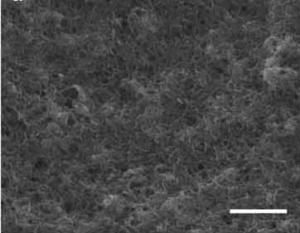A nanotechnology expert at Brown University, found a way to regenerate the body's natural cartilage by developing a synthetic surface that attracts cartilage-producing cells. These cells are then stimulated to multiply using electrical waves

Scientists have been fighting hard for a long time to help those suffering from cartilage wear and tear. An accepted contemporary method is the injection of an artificial gel capable of imitating the natural ability of cartilage to act as a "shock absorber" in the body. But this treatment is only temporary, and requires repeated injections over time.
Now, researcher Thomas Webster, an expert in nanotechnology at Brown University, has found a way to regenerate the natural cartilage in the body by developing a synthetic surface that attracts cartilage-producing cells. These cells are then stimulated to multiply using electrical waves. This is the first study to demonstrate increased cartilage regeneration with this method. "Cartilage regeneration is a very problematic issue," says Webster, an associate professor in the Department of Engineering and the Department of Orthopedics at Brown University.
"You don't feel any pain as a result of the erosion of the cartilage until the moment serious damage has already occurred and the bones are rubbing against each other. That's why research that will help the regeneration of cartilage is so important." Webster's work uses carbon nanotubes, which are molecular-sized tubes of graphitic carbon and are the strongest and most durable fibers known today and also allow for the conduction of electricity. They are studied vigorously and in detail in all parts of the world for a variety of applications in the fields of commerce, industry and medicine. The research team discovered that the nanotubes, thanks to their unique surface characteristics, work effectively to stimulate cartilage-producing cells, known in science as chondrocytes. The surface of the tubes is rough - under a microscope they look like a bumpy body. But precisely this rough surface is similar to the contours of natural tissues, so that the cartilage cells see them as a natural and suitable environment for their development. "We are actually deceiving the body," says the lead researcher. "It all lies in the fact that the nanotubes mimic the natural roughness of the tissues."
In a previous study, a micron surface was used, which is smoother than the nanometer one. The researcher says that his group's nano-surfaces work better than the micron ones thanks to their extra roughness and also due to the structural ability to adapt precisely to the worn area, similar to a plaster. The researchers also learned that they are able to stimulate the cartilage cells to grow more densely by applying electric waves to them. The scientists still do not fully understand how the electric current accelerates the growth of these cells, but they believe that this helps the penetration of calcium ions into the cells, since calcium is a key component in the development and growth of cartilage. The team plans to test the cartilage re-production method in humans, and if it succeeds in them, move to humans.
Webster's experiments in cartilage regeneration parallel his research on bone and implant regeneration published last year in the journal Nanotechnology. The principles are exactly the same: bone-forming cells adhere more effectively to rough carbon nanotubes than to other types of surfaces and multiply there rapidly. In addition, experiments in Japan and other countries have shown that applying an electric current accelerates the growth of the cells that produce the bones.
